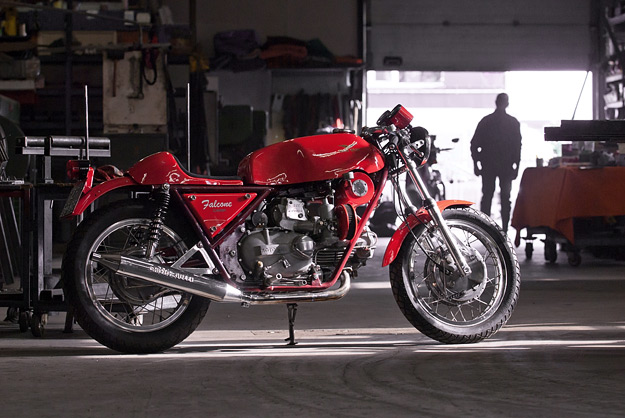
Words and images by Ian Considine for Italian Motor Magazine. It took Leo de Hollander from The Netherlands five years to gradually complete this magnificent supercharged motorcycle. On the 18th of July 2009, after 34 kicks and a wounded right leg, she finally coughed. Ten kicks later, she banged five times. His Falcone Compressore, a 500cc Moto Guzzi Nuovo Falcone converted to a supercharged café racer, finally came to life.
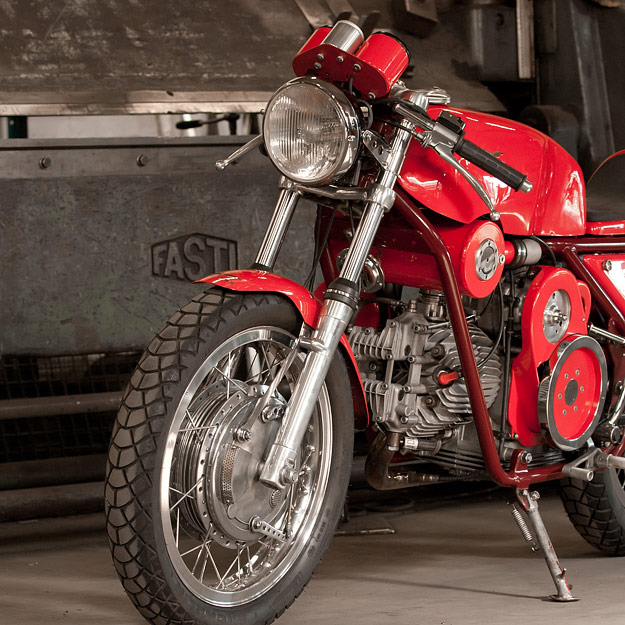
The inspiration behind this magnificently engineered machine was sparked when Leo saw the supercharged Moto Guzzi 250cc factory racer in the Guzzi museum at Mandello. He already had a passion for Guzzi singles, and so the idea of converting a 500cc Nuovo Falcone to a supercharged Guzzi single was born. Some chatting with fellow enthusiasts stirred up the fire. A friend from a local motorcycle museum thought it possible that a Falcone would go fine with a compressor. “I doubted this for five years, but it didn’t stop me from doing it,” Leo states. Measuring various superchargers that he came across during trips to Italy gave no suitable basis, until finally he found an Eaton blower for a classic Mini that had the required dimensions. It was still too long, but a band saw quickly reduced it to the proper length.
Mechanical simplicity is the driving force behind this bike. Any sort of experimentation without any sort of measured feedback resulted in just poor adjustment and a lot of kicking. After some consideration, Leo fitted a Lambda sensor which gave better feedback on the air/fuel ratio, and this led to proper results. (“But that’s about as far as I’ll go with electronics…”) This 40-year-old motorcycle is not supposed to be stuffed with digital engineering. Instead, it embodies the spirit of “pushing the limits” in the days before the digital era. This keeps the character of the Falcone within the 60s and 70s period, instead of taking the easy way out. Hence the beautiful SU carburetor—no injection on this bike. The SU allows for quick adjustments, even while Leo’s actually riding the bike, since it’s in a convenient and accessible position. The engine also features a lightened flywheel, a lighter clutch and a longer first gear. (A good idea with that extra power.) The valve lifter has been removed, which means kicking the bike is more of a pain, but it makes the head more robust. To further increase mechanical durability, a larger V7 oil pump is fitted to cope with the increased violence in the engine.
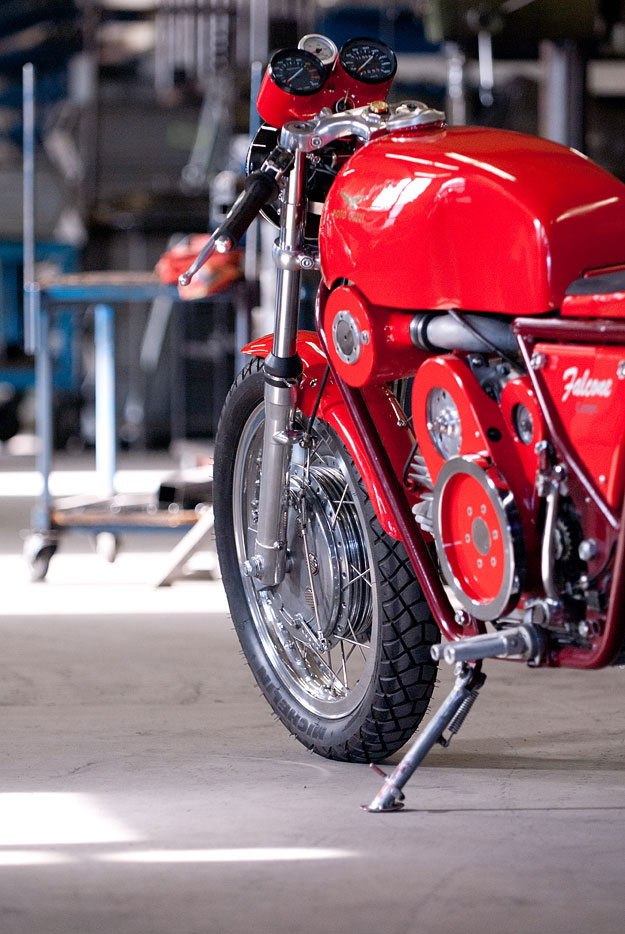
The build of the bike has been executed in a 70s style, taking components from various motorcycles and styles of that era to create a consistent look. Leo has fitted MV Agusta 750S drum brakes, laced with thick spokes into polished Akront rims. The polyester tank was ordered without a bottom to allow adjustments for fitting the plenum. Neatly cut away, a recessed void in the tank’s sides accommodates the characteristic polmone (pressure chamber).
The left side of the engine is also amazing. Here we see the propulsion of the blower and how the generator works. Both are fed via ‘V’ belts, which required some extra space on the axle, so the flywheel had to be mounted a little outward. No problem for Leo. He’s quite a wizard when it comes to fabrication—he owns a welding and construction company. You could say that metal flows through his veins, and his many skills are clearly visible in this bike.
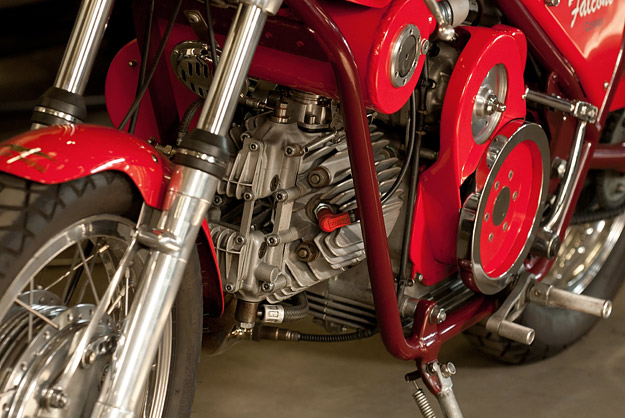
After finishing the bike in 2009, Leo tried different ignition and carburetion settings. “In the beginning there was little information on the pressure in the polmone, so a friend kindly lent me a pressure dial which supplied the necessary feedback”. Stationary fills it with 7.25 to 8.70psi (0.5—0.6 bar), while 4000rpm gives 18.85 to 20psi (1.3—1.4 bar). The release valve opens at 40psi (2.8 bar). “It could be more, but safety first,” says Leo. “Four liters of fuel mixture is frightening. I don’t want a backfire and lose the roof of my garage.”
The air to fuel ratio should be around 11:13 for this engine; the Lambda sensor comes in handy here. It gives proper feedback on adjustments, and makes diagnostics easier. It comes at a price though; the system is consuming 80 watts, draining the battery, so this has to be upgraded. The bike is fitted with a Volker Sachse ignition (second curve), which makes it run properly. It now fires in one kick, warm or cold (if she’s in the mood).
Riding the Compressore is “magnificent” says Leo. “In fourth gear she still pulls instead of dragging along. There’s plenty of low-end power, and full throttle is a real joy.” Leo estimates it has around 40/45 HP.” Not consistently though, the Compressore is moody sometimes. ‘Character’ you could say, just like a lot of Italian machines. The recently revised cylinder head, with different timing from the Volker Sachse ignition, gives a more consistent bang lately.
“It runs properly, and its first year of life has been great fun. Besides the riding, the enthusiastic reactions at every meeting I attend are perhaps most rewarding.” Sharing the passione with other Guzzisti is just as important for Leo.
Up to now, the Falcone has travelled over 2,000 kilometers. This winter, it’s off to the dyno to get a proper adjustment. The Guzzi consumed more money on pistons than fuel (piston number three just went in), hence the development of oil cooling for the piston. Leo is currently working on a Daytona oil pump to fit, which should reduce the piston temperature considerably, so making the motor more durable. There is enough space in the engine, so a few minor adjustments have to be made to fit it.
In the meanwhile, work continues on the other projects. A Guzzi 700cc V4 (yes, that’s merging two V35 engines), and a “dynamic variable flywheel” for the Falcone series. An 8kg two-piece flywheel that disengages 4kg above 1000-1200 rpm for quick acceleration. Pretty interesting …
[Check out Issue 3 of Italian Motor Magazine for more images of this bike and other vintage two-wheeled goodness. Or better still, subscribe.]
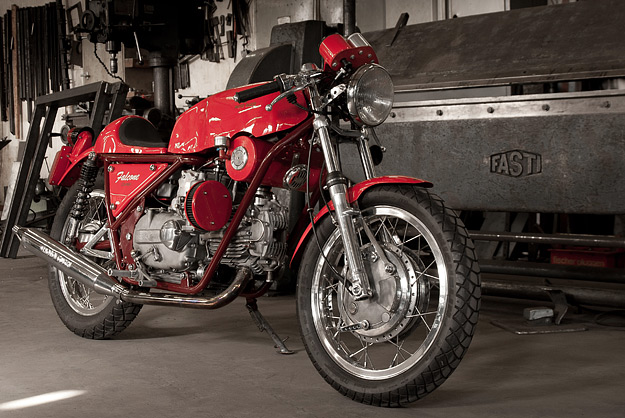








No comments:
Post a Comment